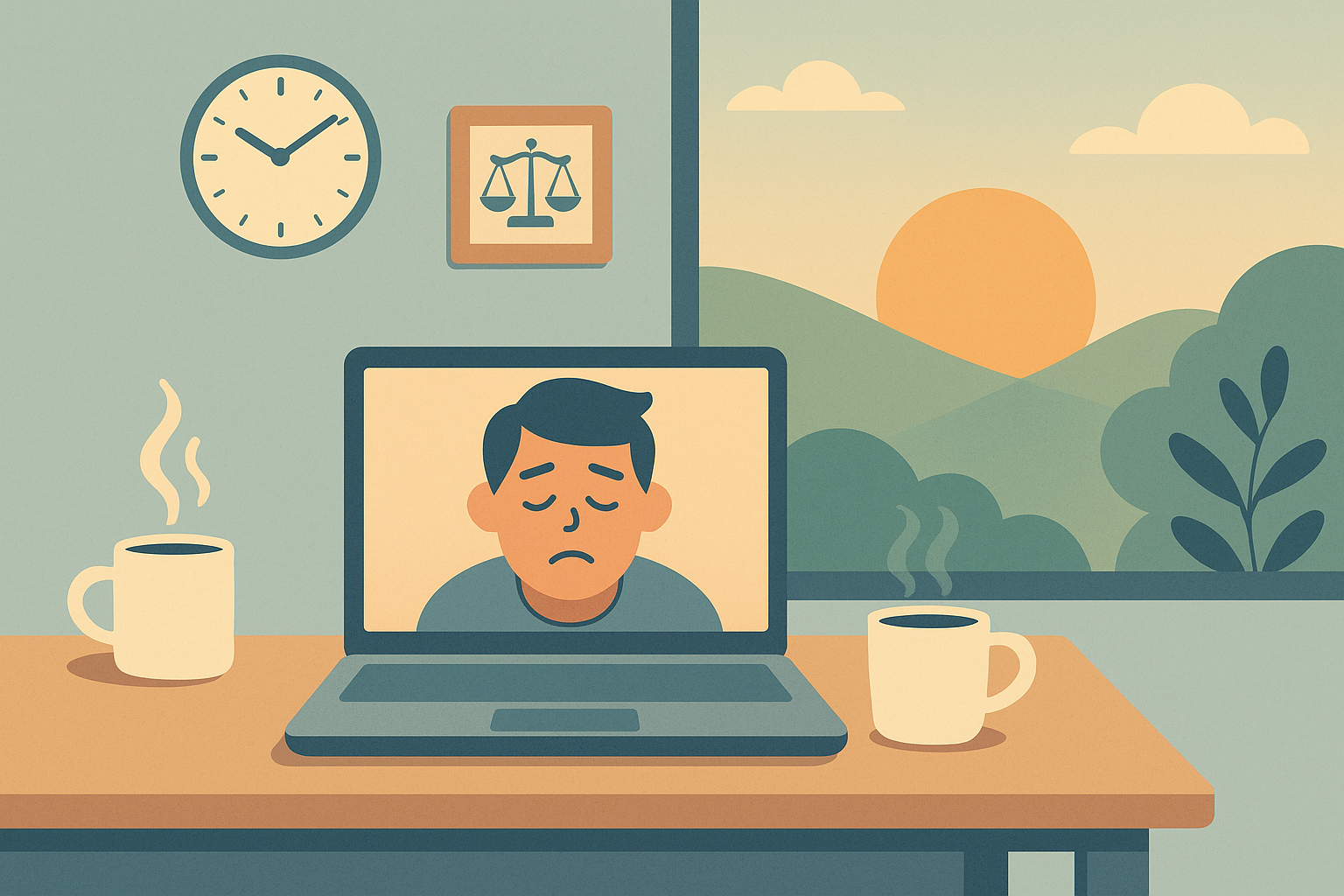Slack pings at 10 p.m., blurred boundaries, and the quiet pressure to stay “green” online—remote work freedom can easily morph into fatigue. Working from home certainly has its advantages, but it also comes with its stressors and struggles!
Spot the Red Flags Early
Before anything else can happen recognizing that you’re sliding into the burnout zone is crucial.
Here are a few signals almost everyone misses:
| Subtle Sign | What It Really Means |
|---|---|
| “Phantom Pings”—you swear you heard Slack or Teams buzz, but nothing’s there. | Your brain’s stuck in hyper-alert mode. |
| Zoom-fatigue naps that leave you groggy, not refreshed. | Cognitive overload—too many on-camera micro-cues to process. |
| Weekend guilt—you finally log off, then feel anxious you’re “wasting time.” | Work–life boundaries are leaking. |
If two or more ring true, it’s time to intervene.
The 5-Day Reset Challenge
Here’s a lightweight, science-backed routine you can run next week—no PTO needed—to yank yourself out of burnout autopilot:
| Day | Micro-Habit | Why It Works |
|---|---|---|
| Monday | Do a real commute simulation: 10-minute walk before and after work. | Physical transitions cue your brain that “work mode” is on/off. |
| Tuesday | Switch all meetings to audio-only unless screens are essential. | Reduces Zoom fatigue by 30–40 % according to Stanford’s Virtual Human Interaction Lab. |
| Wednesday | Block 90 minutes for “deep work”—phone in Airplane Mode. | Creates flow; offsets attention scatter from chat pings. |
| Thursday | End the workday with a Done List (not a To-Do list). | Converts a vague sense of “never enough” into visible wins. |
| Friday | Schedule a 2-hour social block IRL—coffee with a friend, pickup hoops, anything offline. | Social reset counteracts isolation and recharges mood. |
Run the challenge, then rate your energy on a 1–10 scale each evening. Most people jump 2–3 points by Friday.
Make Your Space Work for You
Even tiny tweaks can un-cramp your body and mind:
- Swap your chair’s casters for stationary glides—forces micro-standing breaks.
- Raise your laptop on a stack of books until the webcam hits eye level; slouching less = more oxygen flow.
- Add a “green view.” A NASA meta-study shows a single desk plant or window view can drop cortisol up to 15 %. And lower stress means a happier healthier you.
Quick hack: Can’t buy an expensive sit/stand desk? Put your keyboard on an ironing board—it’s adjustable and costs $0 if you already own one.
Master Asynchronous Work—Your Burnout Antidote
Always-on chat is the silent killer. Shift 50 % of your communication to async:
- Loom or Dropbox Capture videos instead of live walk-throughs—teammates reply on their schedule.
- Thread first, DM second: Post questions in public channels; lurkers answer when they’re fresh, cutting meeting load.
- Use “status recipes.” Example:
⏰ Deep work til 2 PM—text if urgent.It trains colleagues to respect focus windows.
The result? Fewer context switches and a calmer brain.
Manager Toolkit: Burnout-Proof Your Team
If you lead people, you control structural stressors:
- Declare “camera-optional” by default. Employees who keep video off report 22 % lower exhaustion (Harvard Business Review, 2024).
- Rotate meeting-free days. One week it’s Monday, next week Wednesday—keeps calendars breathable.
- Normalize mental-health PTO. Stating, “I’m taking a reset day” should be as routine as visiting the dentist.
- Reward output, not green dots. Celebrate finished projects and quality metrics, not response speed.
Case Study: How One Startup Cut Burnout 40 % in 3 Months
Scenario: SaaS firm, 45 fully remote employees, attrition spiking.
Fixes Implemented:
- Adopted a three-tier priority system (
P1 immediate,P2 24 h,P3 async). - Instituted Friday Focus Blocks, no Slack notifications company-wide.
- Reimbursed up to $500 for ergonomics per employee.
Outcomes:
- Self-reported burnout dropped from 68 % to 28 %.
- Shipping velocity (Jira story points) actually rose 12 %—proof less fire-drill chatter boosts productivity.
Long-Term Habits to Lock In Balance
- Quarterly “energy audits.” Track hours worked, meetings attended, and workout frequency; tweak before sliding.
- Skill stacking: Rotate into new projects every six months—novelty is a cognitive refresh.
- Boundaried tech: Keep a second phone with zero work apps for weekends.
Remember: burnout isn’t a personal failure—it’s a systems problem. When you begin to notice the signs it’s time to take a step back and reassess.
But with small, intentional shifts, you can rebuild a rhythm that fuels both career and life.
TL;DR Playbook
- Recognize the warning signs (phantom pings, Zoom-fatigue naps).
- Run the 5-Day Reset Challenge next week.
- Upgrade your workspace on a shoestring.
- Move half your communication to async.
- If you’re a manager, hard-code balance into team norms.
Do that, and remote work becomes what it was supposed to be all along: freedom, not fatigue.





